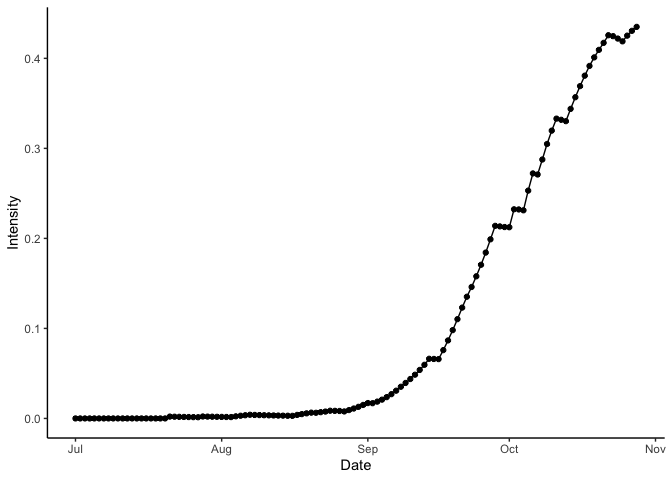All active development has ceased in this repository due to GitHub's continued pivot towards AI. It has moved to https://codeberg.org/adamhsparks/epicrop. This repository will be deleted in the future.
{epicrop} Simulation Modelling of Crop Diseases Using a Susceptible-Exposed-Infectious-Removed (SEIR) Model
A fork of {cropsim}
(Hijmans et al. 2009) designed to make using the EPIRICE model (Savary
et al. 2012) for rice diseases easier to use. This version provides
easy to use functions to fetch weather data from NASA POWER, via the
{nasapower} package
(Sparks 2018, Sparks 2020) and predict disease intensity of five rice
diseases using a generic SEIR model (Zadoks 1971) function, SEIR().
The original EPIRICE manuscript, Savary et al. (2012), which details the model and results of its use to model global epidemics of rice diseases, was published in Crop Protection detailing global unmanaged disease risk of bacterial blight, brown spot, leaf blast, sheath blight and rice tungro, which are included in this package.
You can easily simulate any of the five diseases for rice grown anywhere
in the world for years from 1983 to near current using get_wth() to
fetch data from the NASA POWER web API.
Alternatively, you can supply your own weather data for any time period
as long as it fits the model’s requirements.
{epicrop} is not yet on CRAN. You can install it this way.
if (!require("remotes"))
install.packages("remotes")
remotes::install_github("adamhsparks/epicrop",
build_vignettes = TRUE
)First you need to provide weather data for the model; {epicrop} provides
the get_wth() function to do this. Using it you can fetch weather data
for any place in the world from 1983 to near present by providing the
and latitude and dates or length of rice growing season as shown below.
library("epicrop")
# Fetch weather for year 2000 wet season for a 120 day rice variety at the IRRI
# Zeigler Experiment Station
wth <- get_wth(
lonlat = c(121.25562, 14.6774),
dates = "2000-07-01",
duration = 120
)
wth
#> YYYYMMDD DOY TEMP RHUM RAIN LAT LON
#> 1: 2000-07-01 183 25.30 92.19 23.12 14.6774 121.2556
#> 2: 2000-07-02 184 26.13 86.00 17.34 14.6774 121.2556
#> 3: 2000-07-03 185 25.51 94.19 29.08 14.6774 121.2556
#> 4: 2000-07-04 186 25.81 92.44 13.00 14.6774 121.2556
#> 5: 2000-07-05 187 25.97 92.31 32.20 14.6774 121.2556
#> ---
#> 117: 2000-10-25 299 25.82 89.75 12.04 14.6774 121.2556
#> 118: 2000-10-26 300 25.44 94.94 13.03 14.6774 121.2556
#> 119: 2000-10-27 301 25.74 91.44 11.54 14.6774 121.2556
#> 120: 2000-10-28 302 25.44 91.88 74.20 14.6774 121.2556
#> 121: 2000-10-29 303 24.97 94.12 29.11 14.6774 121.2556Once you have the weather data, run the model for any of the five rice diseases by providing the emergence or crop establishment date for transplanted rice.
bb <- predict_bacterial_blight(wth, emergence = "2000-07-01")
bb
#> simday dates sites latent infectious removed senesced
#> 1: 1 2000-07-01 100.0000 0.00000 0.0000 0.0000 0.000000
#> 2: 2 2000-07-02 108.6875 0.00000 0.0000 0.0000 1.000000
#> 3: 3 2000-07-03 118.1002 0.00000 0.0000 0.0000 2.086875
#> 4: 4 2000-07-04 128.2934 0.00000 0.0000 0.0000 3.267877
#> 5: 5 2000-07-05 139.3254 0.00000 0.0000 0.0000 4.550811
#> ---
#> 116: 116 2000-10-24 1453.0383 107.60598 953.2163 217.8993 2095.744599
#> 117: 117 2000-10-25 1429.1891 77.30207 952.9399 248.4797 2140.855357
#> 118: 118 2000-10-26 1380.4038 73.81997 947.4256 281.2134 2187.881013
#> 119: 119 2000-10-27 1332.8691 69.34615 938.4942 315.9354 2236.407049
#> 120: 120 2000-10-28 1286.3824 64.14358 926.0857 352.6359 2286.436253
#> rateinf rtransfer rgrowth rsenesced diseased intensity AUDPC lat
#> 1: 0.00000 0.00000 9.68750 1.000000 0.000 0.0000000 12.39699 14.6774
#> 2: 0.00000 0.00000 10.49959 1.086875 0.000 0.0000000 12.39699 14.6774
#> 3: 0.00000 0.00000 11.37416 1.181002 0.000 0.0000000 12.39699 14.6774
#> 4: 0.00000 0.00000 12.31499 1.282934 0.000 0.0000000 12.39699 14.6774
#> 5: 0.00000 0.00000 13.32593 1.393254 0.000 0.0000000 12.39699 14.6774
#> ---
#> 116: 0.00000 30.30391 21.26159 45.110758 1278.722 0.4219893 12.39699 14.6774
#> 117: 23.73737 27.21946 21.97777 47.025655 1278.722 0.4188944 12.39699 14.6774
#> 118: 21.31678 25.79060 22.30807 48.526036 1302.459 0.4252267 12.39699 14.6774
#> 119: 19.08944 24.29201 22.63192 50.029205 1323.776 0.4305705 12.39699 14.6774
#> 120: 17.03536 0.00000 22.94393 47.492428 1342.865 0.4349575 12.39699 14.6774
#> lon
#> 1: 121.2556
#> 2: 121.2556
#> 3: 121.2556
#> 4: 121.2556
#> 5: 121.2556
#> ---
#> 116: 121.2556
#> 117: 121.2556
#> 118: 121.2556
#> 119: 121.2556
#> 120: 121.2556Lastly, you can visualise the result of the model run.
library("ggplot2")
ggplot(data = bb,
aes(x = dates,
y = intensity)) +
labs(y = "Intensity",
x = "Date") +
geom_line() +
geom_point() +
theme_classic()
Bacterial blight disease progress over time. Results for wet season year 2000 at IRRI Zeigler Experiment Station shown. Weather data used to run the model were obtained from the NASA Langley Research Center POWER Project funded through the NASA Earth Science Directorate Applied Science Program.
-
Please report any issues or bugs.
-
License: GPL-3
-
To cite {epicrop}, please use the output from
citation(package = "epicrop").
Please note that the epicrop project is released with a Contributor Code of Conduct. By contributing to this project, you agree to abide by its terms.
Robert J. Hijmans, Serge Savary, Rene Pangga and Jorrel Aunario. (2009). Simulation modeling of crops and their diseases. R package version 0.2-6.
Serge Savary, Andrew Nelson, Laetitia Willocquet, Ireneo Pangga and Jorrel Aunario.(2012). Modeling and mapping potential epidemics of rice diseases globally. Crop Protection, Volume 34, Pages 6-17, ISSN 0261-2194 DOI: 10.1016/j.cropro.2011.11.009.
Serge Savary, Stacia Stetkiewicz, François Brun, and Laetitia Willocquet. Modelling and Mapping Potential Epidemics of Wheat Diseases-Examples on Leaf Rust and Septoria Tritici Blotch Using EPIWHEAT. (2015). European Journal of Plant Pathology 142, no. 4:771–90. DOI: 10.1007/s10658-015-0650-7.
Adam Sparks (2018). nasapower: A NASA POWER Global Meteorology, Surface Solar Energy and Climatology Data Client for R. Journal of Open Source Software, 3(30), 1035, DOI: 10.21105/joss.01035.
Adam Sparks (2021). nasapower: NASA-POWER Data from R. DOI: 10.5281/zenodo.1040727, R package version 4.0.0, URL: https://CRAN.R-project.org/package=nasapower.
Jan C. Zadoks. (1971). Systems Analysis and the Dynamics of Epidemics. Phytopathology 61:600. DOI: 10.1094/Phyto-61-600.

